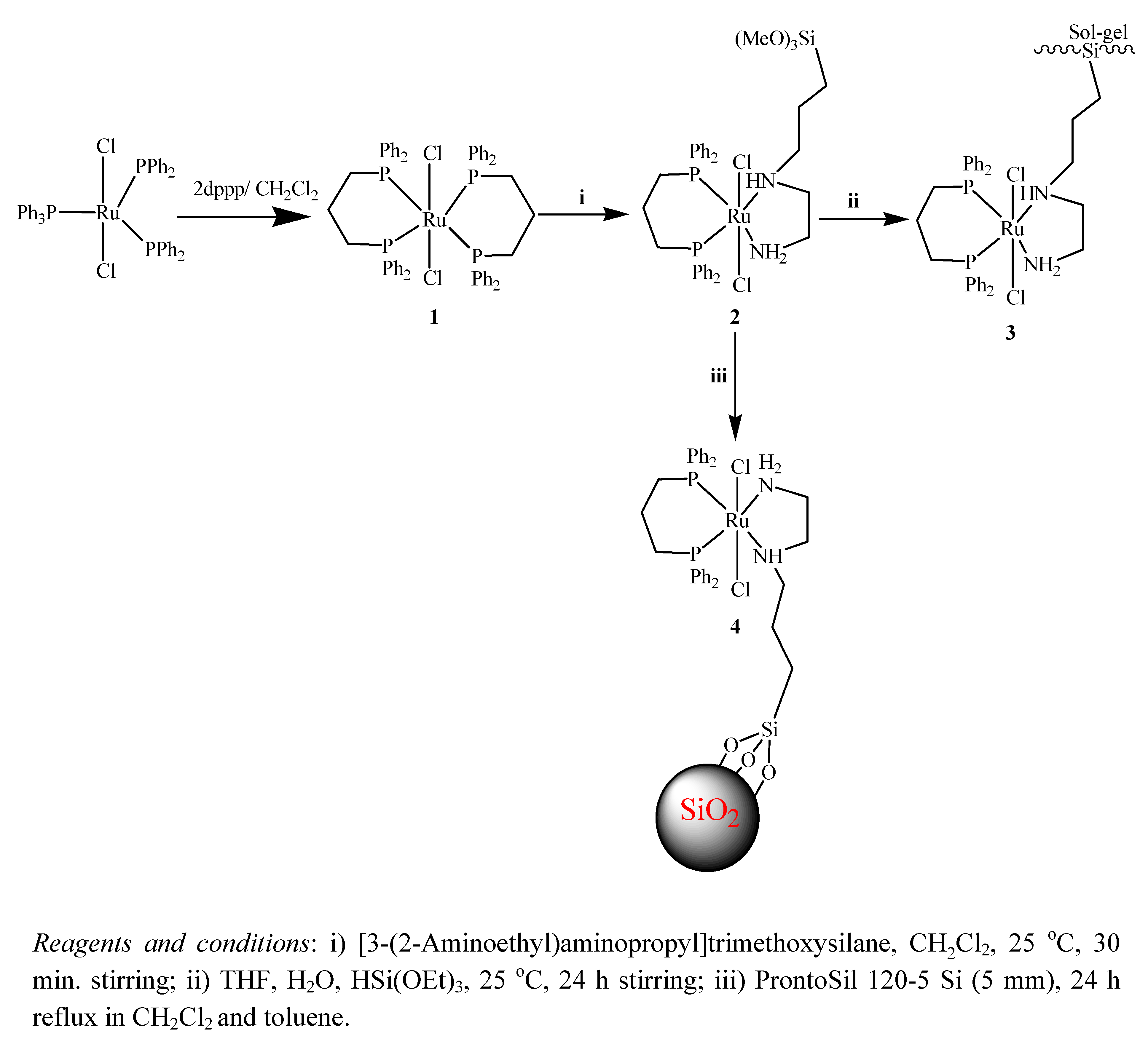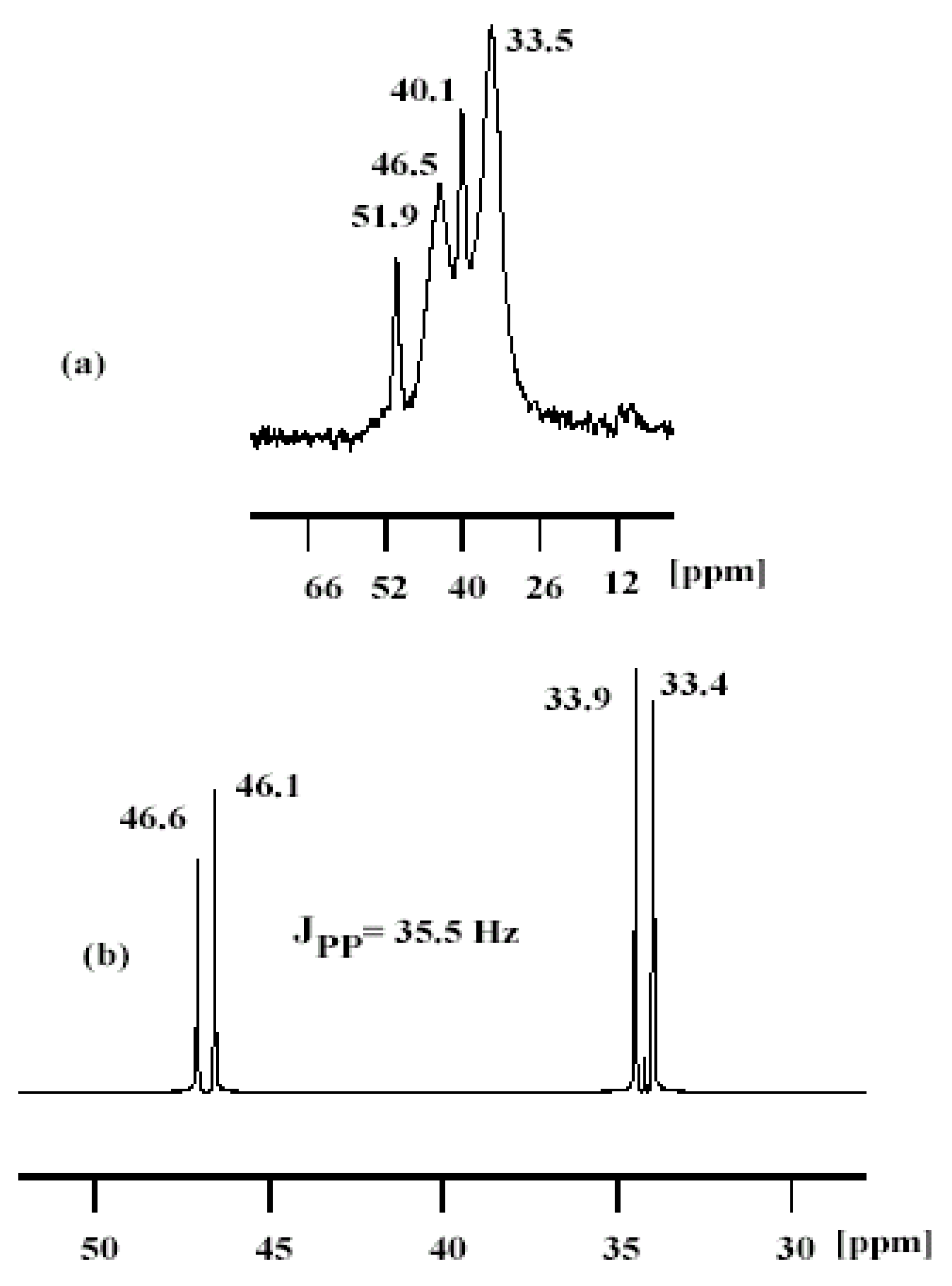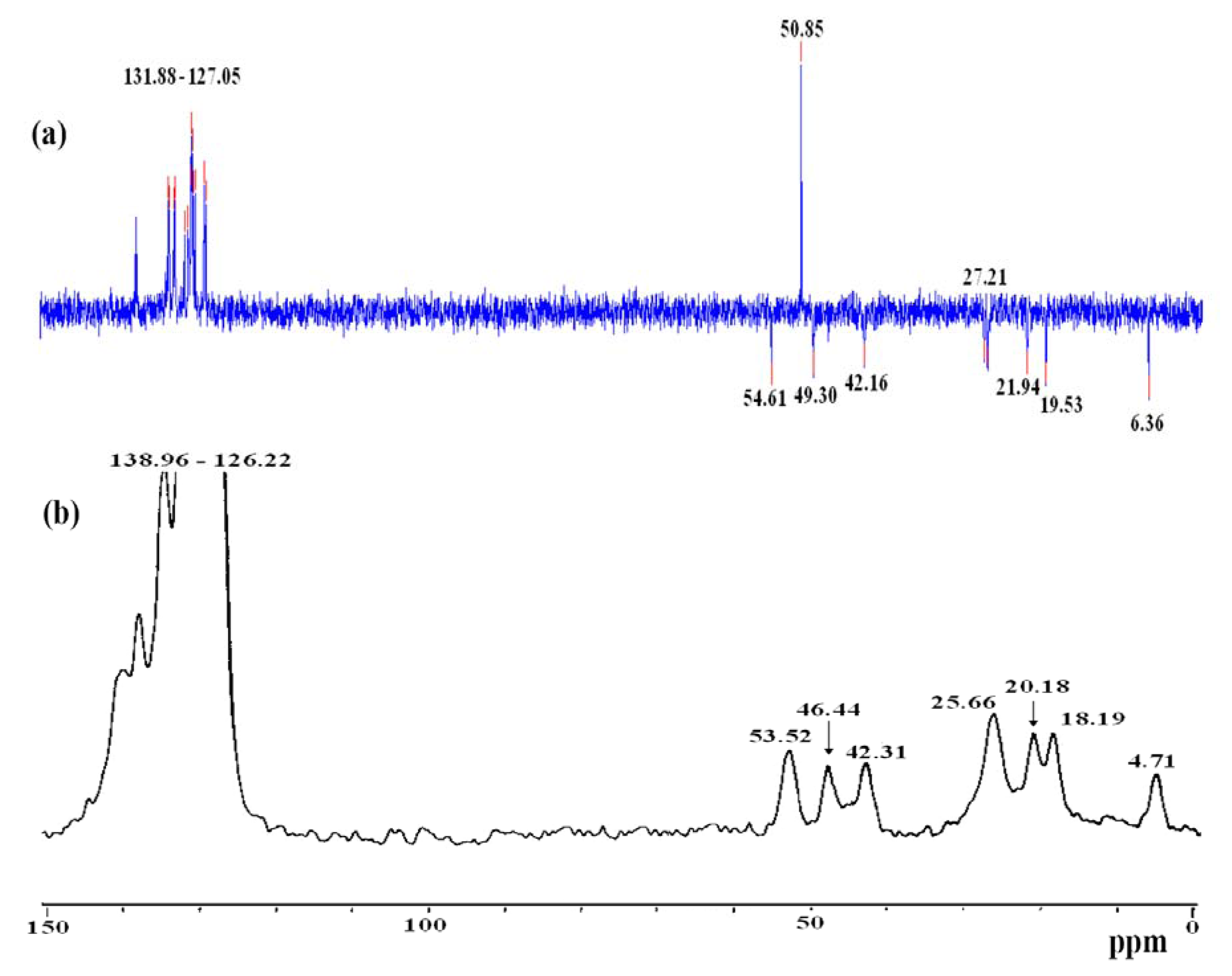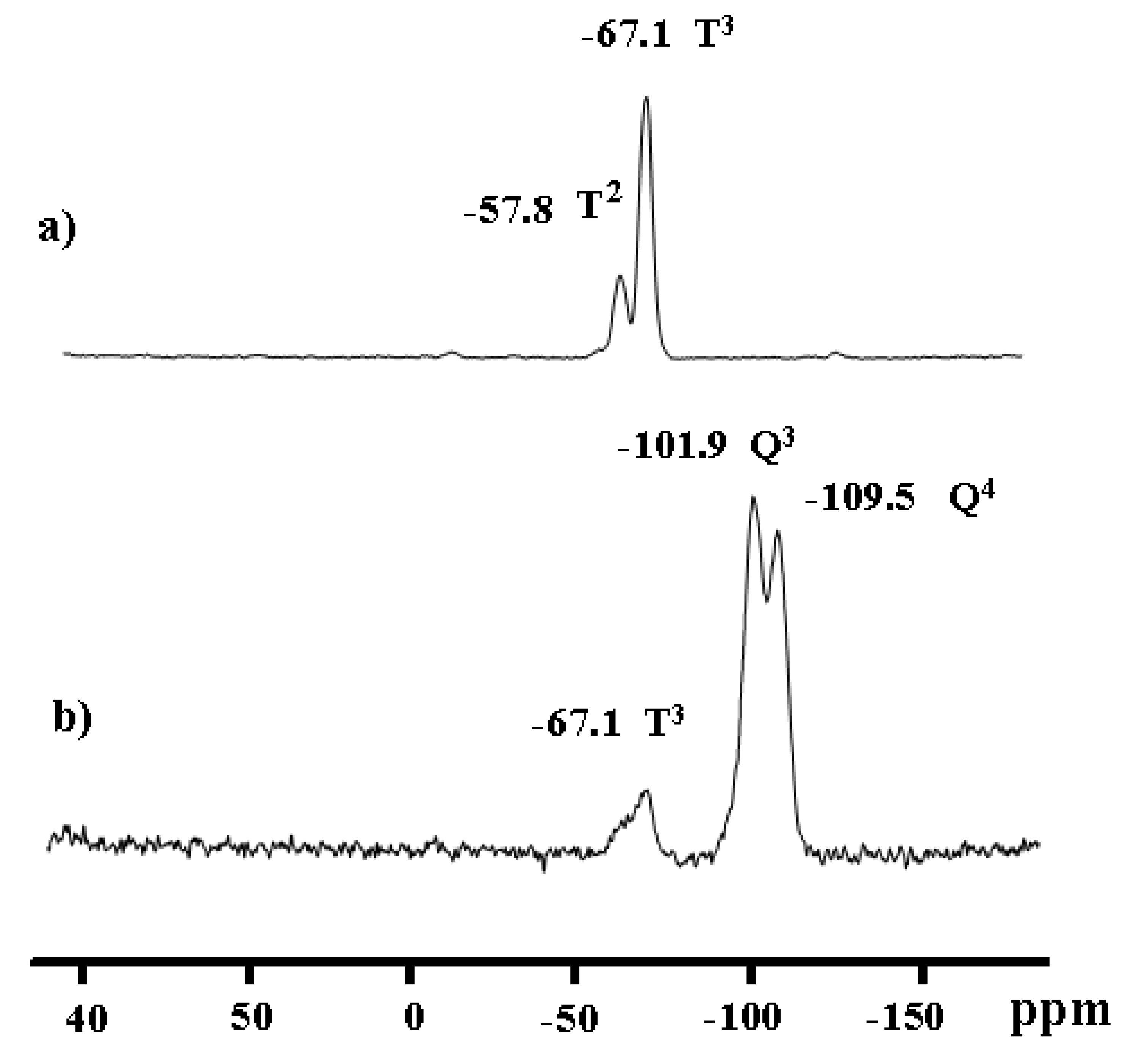Synthesis and Characterization of Novel Inorganic-Organic Hybrid Ru(II) Complexes and Their Application in Selective Hydrogenation
Abstract
:1. Introduction
2. Results and Discussion
2.1. Synthesis of ruthenium(II) complexes [1-4]

2.2. NMR and IR spectroscopic investigations



2.3. EXAFS measurement of xerogel 3

| A-Bsa | Nb | R c [Å] | σ d [Å] | ΔE0e [eV] | k-range [Å-1] | Fit-Index |
|---|---|---|---|---|---|---|
| Ru – N | 2 | 2.19 ± 0.02 | 0.050 ± 0.005 | 22.72 | 3.0 - 16.0 | 32.24 |
| Ru – P | 2 | 2.26 ± 0.02 | 0.055 ± 0.006 | |||
| Ru – Cl | 2 | 2.41 ± 0.03 | 0.063 ± 0.007 |
2.4. Catalytic activity of complexes 2-4 in the hydrogenation of α,ß-unsaturated carbonyl compounds.

| Substrate | Complex | Conversion (%)b | C=O Selectivity (%)b | TOFc | |
|---|---|---|---|---|---|
| 1 | Sub1 | 1 | 0 | 0 | 0 |
| 2 | Sub1 | 2 | >99 | >99 | 1220 |
| 3 | Sub2 | 2 | >99 | >99 | 1205 |
| 4 | Sub3 | 2 | >99 | >99 | 1190 |
| 5 | Sub1 | 2 | 0 | 0 | 0 |
| 6 | Sub1 | 3d | 98 | 97 | 113 |
| 7 | Sub2 | 3d | 95 | 96 | 120 |
| 8 | Sub3 | 3d | 93 | 95 | 108 |
| 9 | Sub1 | 4d | 97 | 94 | 128 |
| 10 | Sub2 | 4d | 95 | 95 | 102 |
| 11 | Sub3 | 4d | 96 | 94 | 110 |
3. Experimental
3.1. General remarks, materials, and instrumentation
3.2. General procedure for the preparation of the complex 2
3.3. General procedure for sol–gel processing of xerogel 3
3.4. General procedure for surface modifiedmaterial 4
3.5. General procedure for the catalysis studies
4. Conclusions
Acknowledgements
References and Notes
- Xi, Z.; Hao, W.; Wang, P.; Cai, M. Ruthenium(III) chloride catalyzed acylation of alcohols, phenols, and thiols in room temperature ionic liquids. Molecules 2009, 14, 3528–3537. [Google Scholar] [CrossRef]
- Drozdzak, R.; Allaert, B.; Ledoux, N.; Dragutan, I.; Dragutan, V.; Verpoort, F. Ruthenium complexes bearing bidentate Schiff base ligands as efficient catalysts for organic and polymer syntheses. Coord. Chem. Rev. 2005, 249, 3055–3074. [Google Scholar] [CrossRef]
- Tfouni, E.; Doro, F.; Gomes, A.; Silva, R.; Metzker, G.; Grac, P.; Benini, Z.; Franco, D. Immobilized ruthenium complexes and aspects of their reactivity. Coord.Chem. Rev. 2010, 254, 355–371. [Google Scholar]
- Warad, I.; Siddiqui, M.; Al-Resayes, S.; Al-Warthan, A.; Mahfouz, R. Synthesis, characterization, crystal structure and chemical behavior of [1,1-bis(diphenylphosphinomethyl)ethene]ruthenium-(II) complex toward primary alkylamine addition. Trans. Met. Chem. 2009, 34, 347–354. [Google Scholar] [CrossRef]
- Duraczynska, D.; Serwicka, E. M.; Drelinkiewicz, A.; Olejniczak, Z. Ruthenium(II) phosphine/ mesoporous silica catalysts: The impact of active phase loading and active site density on catalytic activity in hydrogenation of phenylacetylene. Appl. Catal. A. Gen. 2009, 371, 166–172. [Google Scholar] [CrossRef]
- Lindner, E.; Lu, Z-L.; Mayer, A. H.; Speiser, B.; Tittel, C.; Warad, I. Cyclic voltammetric redox screening of homogeneous ruthenium(II) hydrogenation catalysts. Electrochem. Commun. 2005, 7, 1013–1020. [Google Scholar] [CrossRef]
- Premkumar, J.; Khoo, S. Immobilization of ruthenium(II)bipyridyl complex at highly oxidized glassy carbon electrodes. Electrochem. Commun. 2004, 6, 984–989. [Google Scholar] [CrossRef]
- Clarke, M. Ruthenium metallopharmaceuticals. Coord. Chem. Rev. 2002, 232, 69–93. [Google Scholar] [CrossRef]
- Noyori, R. Asymmetric Catalysis in Organic Synthesis; J. Wiley and Sons: New York, NY, USA, 1994. [Google Scholar]
- Noyori, R. Asymmetric Catalysis: Science and Opportunities. Adv. Synth. Catal. 2003, 345, 15–32, (Nobel Lecture).. [Google Scholar] [CrossRef]
- Lindner, E.; Warad, I.; Eichele, K.; Mayer, H. A. Synthesis and structures of an array of diamine(ether-phosphine)ruthenium(II) complexes and their application in the catalytic hydrogenation of trans-4-phenyl-3-butene-2-one. Inorg. Chim. Acta 2003, 350, 49–56. [Google Scholar] [CrossRef]
- Lu, Z-L.; Eichele, K.; Warad, I.; Mayer, H. A.; Lindner, E.; Jiang, Z.; Schurig, V. Bis(methoxyethyldimethylphosphine)ruthenium(II) complexes as transfer hydrogenation catalysts. Z. Anorg. Allg. Chem. 2003, 629, 1308–1315. [Google Scholar] [CrossRef]
- Warad, I.; Lindner, E.; Eichele, K.; Mayer, A. H. Cationic Diamine(ether–phosphine)ruthenium(II) complexes as precursors for the hydrogenation of trans-4-phenyl-3-butene-2-one. Inorg. Chim. Acta 2004, 357, 1847–1853. [Google Scholar]
- Lindner, E.; Mayer, H. A.; Warad, I.; Eichele, K. Synthesis, characterization, and catalytic application of a new family of diamine(diphosphine)ruthenium(II) complexes. J. Organomet. Chem. 2003, 655, 176–185. [Google Scholar]
- Lindner, E.;; Ghanem, A.; Warad, I.; Eichele, K.; Mayer, H. A.; Schurig, V. Asymmetric hydrogenation of an unsaturated ketone by diamine(ether–phosphine)ruthenium(II) complexes and lipase-catalyzed kinetic resolution: a consecutive approach. Tetrahedron Asymmetry 2003, 14, 1045–1050. [Google Scholar] [CrossRef]
- Ohkuma, T.; Koizumi, M.; Muniz, K.; Hilt, G.; Kabuta, C.; Noyori, R. Trans-RuH(η1- BH4)(binap)(1,2-diamine): A Catalyst for asymmetric hydrogenation of simple ketones under base-Free conditions". J. Am. Chem. Soc. 2002, 124, 6508–6509. [Google Scholar] [CrossRef]
- Hashiguchi, S.; Fujii, A.; Haack, K.-J.; Matsumura, K.; Ikariya, T.; Noyori, R. Kinetic resolution of racemis secondary alcohols by Ru(II)-catalyzed hydrogen transfer. Angew. Chem. Int. Ed. Engl. 1997, 36, 288–290. [Google Scholar] [CrossRef]
- Haack, K.-J.; Hashiguchi, S.; Fujii, A.; Ikariya, T.; Noyori, R. The catalyst precursor, catalyst, and intermediate in the Ru-II-promoted asymmetric hydrogen transfer between alcohols and ketones. Angew. Chem, Int. Ed. Engl. 1997, 36, 285–288. [Google Scholar] [CrossRef]
- Abdur-Rashid, K.; Faatz, M.; Lough, A. J.; Morris, H. R. Catalytic Cycle for the asymmetric hydrogenation of prochiral ketones to chiral alcohols: direct hydride and proton transfer from chiral catalysts trans-Ru(H)2(diphosphine)(diamine) to ketones and direct Addition of Dihydrogen to the Resulting Hydridoamido Complexes. J. Am. Chem. Soc. 2001, 123, 7473–7474. [Google Scholar]
- Lindner, E.; Al-Gharabli, S.; Warad, I.; Mayer, H. A.; Steinbrecher, S.; Plies, E.; Seiler, M.; Bertagnolli, H. Diaminediphosphineruthenium(II) interphase catalysts for the hydrogenation of α,ß-unsaturated ketones. Z. Anorg. Allg. Chem. 2003, 629, 161–171. [Google Scholar] [CrossRef]
- Brunel, D.; Bellocq, N.; Sutra, P.; Cauvel, A.; Laspearas, M.; Moreau, P.; Renzo, F.; Galarneau, A.; Fajula, F. Transition-metal ligands bound onto the micelle-templated silica surface. Coord. Chem. Rev. 1998, 178–180, 1085–1108. [Google Scholar] [CrossRef]
- Lindner, E.; Salesch T.; Brugger, S.; Steinbrecher, S.; Plies, E.; Seiler, M.; Bertagnolli, H.; Mayer, A. M. Accessibility studies of sol-gel processed phosphane-substituted iridium(I) complexes in the interphase. Eur. J. Inorg. Chem. 2002, 1998–2006. [Google Scholar]
- Sayaha, R.; Flochc, M.; Framery, E.; Dufaud, V. Immobilization of chiral cationic diphosphine rhodium complexes in nanopores of mesoporous silica and application in asymmetric hydrogenation. J. Mol. Cat. A. Chem. 2010, 315, 51–59. [Google Scholar] [CrossRef]
- Ohkuma, T.; Takeno, H.; Honda, Y.; Noyori, R. Asymmetric hydrogenation of ketones with polymer-bound BINAP diamine ruthenium catalysts. Adv. Synth. Catal. 2001, 343, 369–375. [Google Scholar]
- Lu, Z-L.; Lindner, E.; Mayer, H. A. Applications of sol-gel-processed interphase Catalysts. Chem. Rev. 2002, 102, 3543–3578. [Google Scholar] [CrossRef]
- Chai, L. T.; Wang, W. W.; Wang, Q. R.; Tao, Q. R. Asymmetric hydrogenation of aromatic ketones with MeO-PEG supported BIOHEP/DPEN ruthenium catalysts. J. Mol. Cat A 2007, 270, 83–88. [Google Scholar] [CrossRef]
- Warad, I. Synthesis and crystal structure of cis-dichloro-1,2-ethylenediamine-bis[1,4-(diphenylphosphino)butane]ruthenium(II) dichloromethane disolvate, RuCl2(C2H8N2) (C28H28P2)-2CH2Cl2. Z. Kristallogr. NCS 2007, 222, 415–417. [Google Scholar]
- Warad, I.; Al-Resayes, S.; Eichele, E. Crystal structure of trans-dichloro-1,3-propanediamine-bis[(2-methoxyethyl)diphenylphosphine]ruthenium(II), RuCl2-(C3H10N2)(C15H17OP)2. Z. Kristallogr. NCS 2006, 221, 275–277. [Google Scholar]
- Lu, Z.-L.; Eichele, K.; Warad, I.; Mayer, H. A. E.; Lindner; Jiang, Z.; Schurig, V. Bis(methoxyethyldimethylphosphine)ruthenium(II) complexes as transfer hydrogenation catalysts. Z. Anorg. Allg. Chem. 2003, 629, 1308–1315. [Google Scholar] [CrossRef]
- Kang, C.; Huang, J.; He, W.; Zhang, F. Periodic mesoporous silica-immobilized palladium(II) complex as an effective and reusable catalyst for water-medium carbon–carbon coupling reactions. J. Organomet. Chem. 2010, 695, 120–127. [Google Scholar]
- Sample Availability: Samples of the compounds are available from the authors.
© 2010 by the authors;
Share and Cite
Warad, I.; Al-Othman, Z.; Al-Resayes, S.; Al-Deyab, S.S.; Kenawy, E.-R. Synthesis and Characterization of Novel Inorganic-Organic Hybrid Ru(II) Complexes and Their Application in Selective Hydrogenation. Molecules 2010, 15, 1028-1040. https://doi.org/10.3390/molecules15021028
Warad I, Al-Othman Z, Al-Resayes S, Al-Deyab SS, Kenawy E-R. Synthesis and Characterization of Novel Inorganic-Organic Hybrid Ru(II) Complexes and Their Application in Selective Hydrogenation. Molecules. 2010; 15(2):1028-1040. https://doi.org/10.3390/molecules15021028
Chicago/Turabian StyleWarad, Ismail, Zeid Al-Othman, Saud Al-Resayes, Salem S. Al-Deyab, and El-Refaie Kenawy. 2010. "Synthesis and Characterization of Novel Inorganic-Organic Hybrid Ru(II) Complexes and Their Application in Selective Hydrogenation" Molecules 15, no. 2: 1028-1040. https://doi.org/10.3390/molecules15021028
APA StyleWarad, I., Al-Othman, Z., Al-Resayes, S., Al-Deyab, S. S., & Kenawy, E.-R. (2010). Synthesis and Characterization of Novel Inorganic-Organic Hybrid Ru(II) Complexes and Their Application in Selective Hydrogenation. Molecules, 15(2), 1028-1040. https://doi.org/10.3390/molecules15021028




